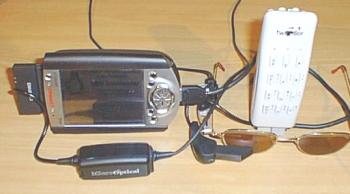Article: A ‘second generation’ iPAQ-based wearable computer
Mar 22, 2002 — by LinuxDevices Staff — from the LinuxDevices Archive — viewsBackground
A “second generation” iPAQ-based wearable computer running Linux has been developed as part of the ongoing non-commercial research efforts of the Multimedia Communications Lab (KOM) at Darmstadt University of Technology in Darmstadt, Germany. In the KOM lab, we are dealing with several aspects of Network Multimedia Communication.
I have for some time been developing a platform for use in experimenting with using mobile systems as clients for IP telephony scenarios, and have previously built prototypes running on an x86 platform, as well as a “first generation” iPAQ-based wearable.
This “second generation” iPAQ-based wearable prototype (see photo below) is much easier to handle, mainly due to the smaller and lighter weight display and also because it needs much less dedicated hardware.

The second generation iPAQ-based wearable computer
About the system
The latest prototype is constructed mainly from off-the-shelf components, and it benefits from the PocketPC/Linux iPAQ dual-boot capability which has recently become available.
The device combines input from a Twiddler chording keyboard with text display output to a serially attached MicroOptical head mounted display (working as “memory mapped” to a Linux standard console/xterm), along with a text-to-speech audio interface using Flite.
Being equipped with a color graphics Voyager PCMCIA VGA card and operating in dual boot (both Linux and PocketPC) mode, it also lets you prepare and present slides while you are working away from your home environment.
The setup has been shown to work successfully in a heterogenous Voice-over-IP / Internet Telephony scenario, and will be used for a number of other Wearable application scenarios in the near future.
Component Approach
One important aspect of the project is the “component approach” taken for hardware. Although the processing power and interface capabilities of the iPAQ-based wearable are well suited for a great number of applications, there will be some instances when its capabilities are not sufficient.
For this reason, the system has been designed to interoperate with more computing-powerful components (e.g. a MPL MIP-520 based Wearable Computer) in a WLAN coupled wireless network, when required. For example, we might need additional storage, interfaces (e.g. USB host for cameras), or processing power (e.g. for speech recognition). In such cases, the device can be coupled with other components in a “body area network”, via either wired USB networking or WLAN.
Following this approach, each component can do what it can do best — and components can dynamically be switched on/off or left out for power and/or space efficiency. This is somewhat comparable to what is done in MIT's MIThrill project.
In my project, the combination with a more powerful processing core has been set up using a power-efficient, small x86-architecture AMD Elan based wearable.
What we plan to do with it
Basically, we use it as a mobile client for our IP telephony experiments (a research paper about this approach has already been published).
As a result of the device's unusual input/output facilities — a small head-mounted or PDA “screen”, along with “typing while walking” using a single-handed chording keyboard — which are quite different from our familiar desktop computing environments, the whole area of experimenting with new ways of interacting with the device is very interesting to study. For example, we use a lightweight text-to-speech system to access email (or other text) that we scroll through in a list.
References and resources
- The author's website describing this project in more detail is located here.
- Most of the other components that can also work with the device are described here.
- This work benefits a lot from the very good work that people did when porting Linux to the iPAQ, as well as from the ongoing discussion in the Wearable Mailing List
- Many components for building wearable computers are available from the Wearables Central website.

This article was originally published on LinuxDevices.com and has been donated to the open source community by QuinStreet Inc. Please visit LinuxToday.com for up-to-date news and articles about Linux and open source.